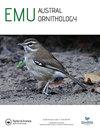Using mitochondrial DNA to identify the provenance of 19th century Kākāpō skins held in Australia’s oldest natural history collection, the Macleay
IF 1.1
4区 生物学
Q3 ORNITHOLOGY
引用次数: 1
Abstract
ABSTRACT Museum specimens of endangered species are important to determine pre-decline population structure and to characterise loss of diversity in surviving populations. Kākāpō (Strigops habroptilus), the critically endangered New Zealand ground parrot, suffered massive population declines in the nineteenth and twentieth centuries resulting in a genetic bottleneck and adverse inbreeding effects. The University of Sydney Chau Chak Wing Museum (formerly the Macleay Museum) holds several Kākāpō study skins in the Macleay Collections (Australia’s oldest natural history collection), obtained in the mid1800s prior to population declines, but with unknown provenance. Here, we used ancient DNA (aDNA) methods to sequence mitochondrial DNA (mtDNA) from nine Macleay skins and compared them to published sequences of North and South Island Kākāpō to establish the provenance of each skin. Phylogeography suggests the skins were collected on the southern west coast of the South Island, excluding the North Island as a source. Genetic results corroborate historical records of scientific field trips in the mid1800s taken by museum directors Sir James Hector and Sir Julius von Haast, who sent the skins to the Macleay from New Zealand. All nine Macleay specimens yielded unique mtDNA genome sequences consistent with previous findings of high mtDNA haplotype diversity in pre-decline Kākāpō, especially within southern South Island populations. The Macleay Collection’s skins are some of the oldest historical museum specimens of Kākāpō to have been genetically analysed and are an important genetic resource for future studies of Kākāpō genomic diversity.利用线粒体DNA鉴定19世纪Kākāpō皮肤的来源,这些皮肤保存在澳大利亚最古老的自然历史收藏中,麦克利
濒危物种博物馆标本对于确定种群衰退前的种群结构和描述幸存种群多样性的丧失具有重要意义。Kākāpō (Strigops habroptilus),极度濒危的新西兰地鹦鹉,在19世纪和20世纪遭受了大规模的人口下降,导致遗传瓶颈和不利的近亲繁殖影响。悉尼大学周泽荣博物馆(原麦克利博物馆)在麦克利收藏(澳大利亚最古老的自然历史收藏)中收藏了几张Kākāpō研究皮肤,这些皮肤是在人口下降之前的19世纪中期获得的,但出处不明。在这里,我们使用古DNA (aDNA)方法对来自9个麦克利皮肤的线粒体DNA (mtDNA)进行测序,并将其与北岛和南岛Kākāpō已发表的序列进行比较,以确定每个皮肤的来源。物种地理学表明,这些皮是在南岛的南部西海岸收集的,不包括北岛作为来源。基因结果证实了19世纪中期博物馆馆长詹姆斯·赫克托爵士和朱利叶斯·冯·哈斯特爵士进行的科学实地考察的历史记录,他们从新西兰把这些皮送到了麦克利博物馆。所有9个麦克利标本都获得了独特的mtDNA基因组序列,这与先前在衰退前Kākāpō(特别是南岛南部种群)发现的高mtDNA单倍型多样性一致。麦克利收藏的皮肤是Kākāpō最古老的历史博物馆标本之一,已经进行了基因分析,是Kākāpō基因组多样性未来研究的重要遗传资源。
本文章由计算机程序翻译,如有差异,请以英文原文为准。
求助全文
约1分钟内获得全文
求助全文
来源期刊

Emu-Austral Ornithology
生物-鸟类学
CiteScore
2.00
自引率
7.70%
发文量
33
审稿时长
>12 weeks
期刊介绍:
Emu – Austral Ornithology is the premier journal for ornithological research and reviews related to the Southern Hemisphere and adjacent tropics. The journal has a long and proud tradition of publishing articles on many aspects of the biology of birds, particularly their conservation and management.
 求助内容:
求助内容: 应助结果提醒方式:
应助结果提醒方式:


